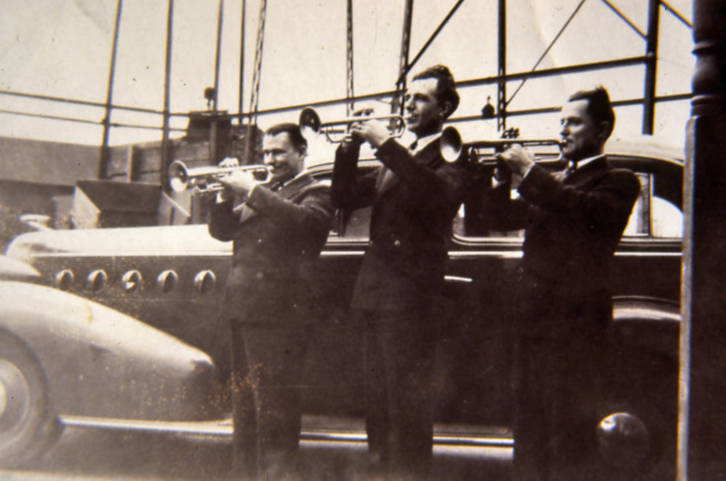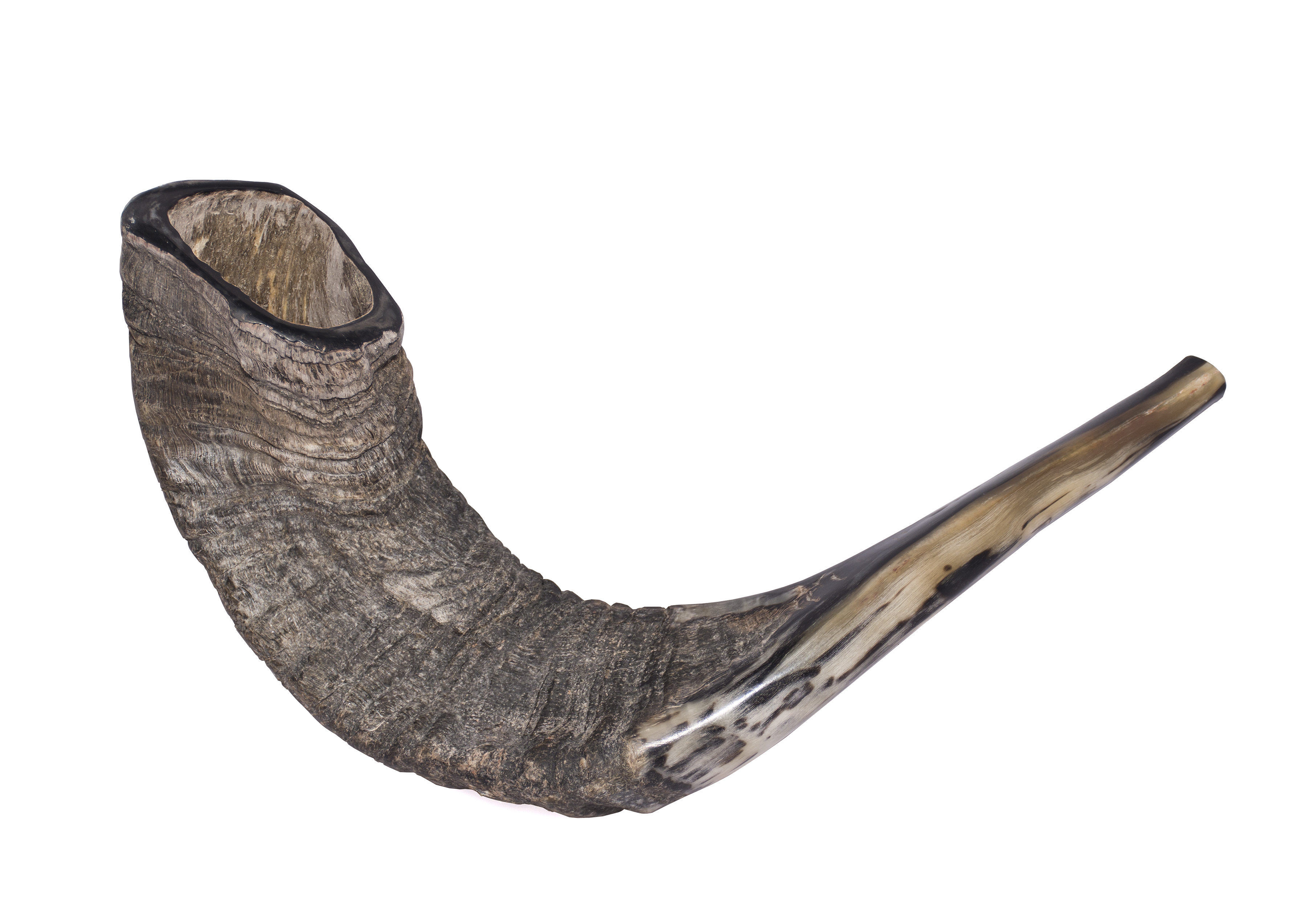|
Bugle
The bugle is one of the simplest brass instruments, normally having no valves or other pitch-altering devices. All pitch control is done by varying the player's embouchure. History The bugle developed from early musical or communication instruments made of animal horns, with the word "bugle" itself coming from "buculus", Latin for bullock ( castrated bull). The earliest bugles were shaped in a coil – typically a double coil, but also a single or triple coil – similar to the modern horn, and were used to communicate during hunts and as announcing instruments for coaches (somewhat akin to today's automobile horn). Predecessors and relatives of the bugle included the post horn, the Pless horn (sometimes called the "Prince Pless horn"), the bugle horn, and the shofar, among others. The ancient Roman army used the buccina. The first verifiable formal use of a brass bugle as a military signal device was the ''Halbmondbläser'', or half-moon bugle, used in Hanover in ... [...More Info...] [...Related Items...] OR: [Wikipedia] [Google] [Baidu] |
Bugle Call
A bugle call is a short tune, originating as a military signal announcing scheduled and certain non-scheduled events on a military installation, battlefield, or ship. Historically, bugles, drums, and other loud musical instruments were used for clear communication in the noise and confusion of a battlefield. Naval bugle calls were also used to command the crew of many warships (signaling between ships being by flaghoist, semaphore, signal lamp or other means). A defining feature of a bugle call is that it consists only of notes from a single overtone series. This is in fact a requirement if it is to be playable on a bugle or equivalently on a trumpet without moving the valves. (If a bandsman plays calls on a trumpet, for example, one particular key may be favored or even prescribed, such as: all calls to be played with the first valve down.) Bugle calls typically indicated the change in daily routines of camp. Every duty around camp had its own bugle call, and since cav ... [...More Info...] [...Related Items...] OR: [Wikipedia] [Google] [Baidu] |
Bugle Scale
The bugle is one of the simplest brass instruments, normally having no valves or other pitch-altering devices. All pitch control is done by varying the player's embouchure. History The bugle developed from early musical or communication instruments made of animal horns, with the word "bugle" itself coming from "buculus", Latin for bullock (castrated bull). The earliest bugles were shaped in a coil – typically a double coil, but also a single or triple coil – similar to the modern horn, and were used to communicate during hunts and as announcing instruments for coaches (somewhat akin to today's automobile horn). Predecessors and relatives of the bugle included the post horn, the Pless horn (sometimes called the "Prince Pless horn"), the bugle horn, and the shofar, among others. The ancient Roman army used the buccina. The first verifiable formal use of a brass bugle as a military signal device was the ''Halbmondbläser'', or half-moon bugle, used in Hanover in 1758. I ... [...More Info...] [...Related Items...] OR: [Wikipedia] [Google] [Baidu] |
Keyed Bugle
The Royal Kent bugle or keyed bugle is a variant of the bugle popular in the 19th century, especially in the English Army in 1856. Its six keys allow pitch to be controlled beyond that possible with a standard bugle. History The first known mention of a bugle with keys appears on April 4 1800 in The Morning Chronicle: However, not until 5 May 1810 was a patent on a five-keyed bugle granted to Yorkshireman Joseph Haliday, entitled "Halliday's icImprovements in the Musical Instrument called the Bugle Horn." Shortly thereafter, in 1811 the first known solos on the instrument were performed by trumpeter Henry Willman, brother of the clarinetist Thomas Lindsay Willman. Performances at the Theatre Royal, Dublin were announced with "Mr. H. WILLMAN will play a Concerto on that highly-improved Instrument, THE Patent Kent Bugle Horn, (INVENTED BY MR. JOSEPH HALLIDAY)". The first book on the instrument, which by then had six keys to enable more tones, was ''Introduction to the Art of Pla ... [...More Info...] [...Related Items...] OR: [Wikipedia] [Google] [Baidu] |
The Rifles
The Rifles is an infantry regiment of the British Army. Formed in 2007, it consists of four Regular battalions and three Reserve battalions, plus a number of companies in other Army Reserve battalions. Each battalion of The Rifles was formerly an individual battalion of one of the two large regiments of the Light Division (with the exception of the 1st Battalion, which is an amalgamation of two individual regiments). Since formation the regiment has been involved in combat operations, first in the later stages of the Iraq War and in the War in Afghanistan. History The Rifles was created as a result of the Future Army Structure review. Under the original announcement, the Light Division would have remained essentially unchanged, with the exception of the Light Infantry gaining a new battalion through the amalgamation of two other regiments, and both gaining a reserve battalion from within the Territorial Army (TA) as it was then called. However, on 24 November 2005, the Minis ... [...More Info...] [...Related Items...] OR: [Wikipedia] [Google] [Baidu] |
Trumpet
The trumpet is a brass instrument commonly used in classical and jazz ensembles. The trumpet group ranges from the piccolo trumpet—with the highest register in the brass family—to the bass trumpet, pitched one octave below the standard B or C trumpet. Trumpet-like instruments have historically been used as signaling devices in battle or hunting, with examples dating back to at least 1500 BC. They began to be used as musical instruments only in the late 14th or early 15th century. Trumpets are used in art music styles, for instance in orchestras, concert bands, and jazz ensembles, as well as in popular music. They are played by blowing air through nearly-closed lips (called the player's embouchure), producing a "buzzing" sound that starts a standing wave vibration in the air column inside the instrument. Since the late 15th century, trumpets have primarily been constructed of brass tubing, usually bent twice into a rounded rectangular shape. There are many di ... [...More Info...] [...Related Items...] OR: [Wikipedia] [Google] [Baidu] |
Brass Instrument
A brass instrument is a musical instrument that produces sound by sympathetic vibration of air in a tubular resonator in sympathy with the vibration of the player's lips. Brass instruments are also called labrosones or labrophones, from Latin and Greek elements meaning 'lip' and 'sound'. There are several factors involved in producing different pitches on a brass instrument. Slides, valves, crooks (though they are rarely used today), or keys are used to change vibratory length of tubing, thus changing the available harmonic series, while the player's embouchure, lip tension and air flow serve to select the specific harmonic produced from the available series. The view of most scholars (see organology) is that the term "brass instrument" should be defined by the way the sound is made, as above, and not by whether the instrument is actually made of brass. Thus one finds brass instruments made of wood, like the alphorn, the cornett, the serpent and the didgeridoo, while s ... [...More Info...] [...Related Items...] OR: [Wikipedia] [Google] [Baidu] |
French Horn
The French horn (since the 1930s known simply as the horn in professional music circles) is a brass instrument made of tubing wrapped into a coil with a flared bell. The double horn in F/B (technically a variety of German horn) is the horn most often used by players in professional orchestras and bands, although the descant and triple horn have become increasingly popular. A musician who plays a horn is known as a horn player or hornist. Pitch is controlled through the combination of the following factors: speed of air through the instrument (controlled by the player's lungs and thoracic diaphragm); diameter and tension of lip aperture (by the player's lip muscles—the embouchure) in the mouthpiece; plus, in a modern horn, the operation of valves by the left hand, which route the air into extra sections of tubing. Most horns have lever-operated rotary valves, but some, especially older horns, use piston valves (similar to a trumpet's) and the Vienna horn uses double-pis ... [...More Info...] [...Related Items...] OR: [Wikipedia] [Google] [Baidu] |
Cornet
The cornet (, ) is a brass instrument similar to the trumpet but distinguished from it by its conical bore, more compact shape, and mellower tone quality. The most common cornet is a transposing instrument in B, though there is also a soprano cornet in E and cornets in A and C. All are unrelated to the Renaissance and early Baroque cornett. History The cornet was derived from the posthorn by applying rotary valves to it in the 1820s, in France. However, by the 1830s, Parisian makers were using piston valves. Cornets first appeared as separate instrumental parts in 19th-century French compositions.''Encyclopædia Britannica'', Micropedia, Volume III, William Benton, Chicago Illinois, 1974, p. 156 The instrument could not have been developed without the improvement of piston valves by Silesian horn players Friedrich Blühmel (or Blümel) and Heinrich Stölzel, in the early 19th century. These two instrument makers almost simultaneously invented valves, though it is ... [...More Info...] [...Related Items...] OR: [Wikipedia] [Google] [Baidu] |
Shofar
A shofar ( ; from he, שׁוֹפָר, ) is an ancient musical horn typically made of a ram's horn, used for Jewish religious purposes. Like the modern bugle, the shofar lacks pitch-altering devices, with all pitch control done by varying the player's embouchure. The shofar is blown in synagogue services on Rosh Hashanah and at the end of Yom Kippur; it is also blown every weekday morning in the month of Elul running up to Rosh Hashanah. Shofars come in a variety of sizes and shapes, depending on the choice of animal and level of finish. Bible and rabbinic literature The shofar is mentioned frequently in the Hebrew Bible, the Talmud and rabbinic literature. In the first instance, in , the blast of a shofar emanating from the thick cloud on Mount Sinai makes the Israelites tremble in awe. The shofar was used to announce the new moon and the Jubilee year. The first day of Tishrei (now known as Rosh Hashana) is termed a "memorial of blowing", or "day of blowing", the shofar. ... [...More Info...] [...Related Items...] OR: [Wikipedia] [Google] [Baidu] |




